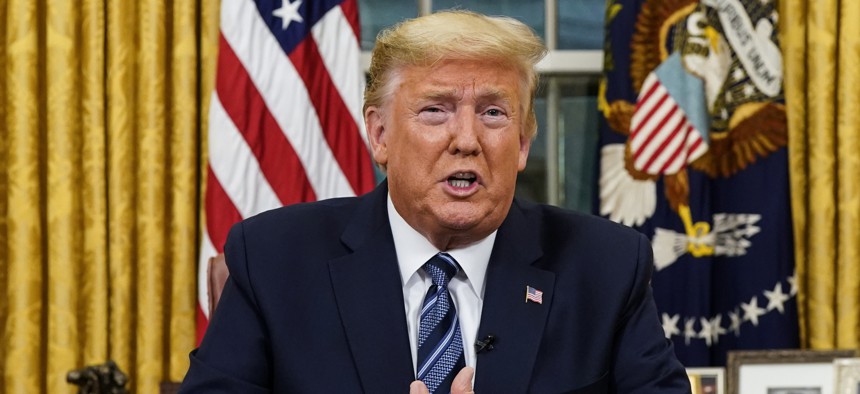
President Donald Trump speaks in an address to the nation from the Oval Office at the White House about the coronavirus Wednesday, March, 11, 2020, in Washington. Doug Mills/The New York Times via AP, Pool
Pentagon Suspends Troop Travel in Affected Countries; Trump Limits Travel from Mainland Europe
Defense Secretary orders 60-day ban on troops, civilians, and families traveling “to, from, or through” Germany, South Korea, Italy, France, others.
Updated, Thursday 7:17 a.m.
The United States will limit travel from mainland Europe for 30 days, starting Friday night, President Trump announced Wednesday, a measure that public-health experts said was unlikely to slow the spread of coronavirus in this country.
Separately, defense and military personnel and their families will be forbidden for 60 days to travel "to, from, or through" countries designated as a Level 3 risk by the Centers for Disease Control and Prevention, Defense Secretary Mark Esper announced. At the time, that list included only Italy, South Korea, China, and Iran. But within hours the CDC updated its Level 3 list to include 29 European countries affected by the virus, including thousands of troops and families in Germany. Servicemembers’ families are also banned from traveling to Level 2 countries, which at the time of the announcement included the UK and Bahrain, but those countries were removed from the list by Thursday morning.
In an Oval Office address on his administration’s handling of the coronavirus outbreak in the United States, Trump mischaracterized his new restrictions, which a Department of Homeland Security statement said were officially imposed by a presidential proclamation signed earlier in the day.
The president said, “We will be suspending all travel from Europe for the next 30 days” with some exceptions for “Americans who have undergone appropriate screenings,” and he added that the restrictions would apply to “trade and cargo.”
But the DHS statement, posted shortly after Trump’s prime-time television speech, said that the ban would be somewhat less sweeping: it will apply to “most foreign nationals who have been in certain European countries” — specifically, the 26 in the Schengen Area — "at any point during the 14 days prior to their scheduled arrival to the United States.”
Trump also misspoke about exempting only "screened" Americans, according to Acting DHS Deputy Secretary Ken Cuccinelli, who later tweeted that the ban does not apply to any "American citizens or legal permanent residents or their families."
And the president himself quickly walked back his own statement that the ban would affect cargo, tweeting within the hour that “trade will in no way be affected by the 30-day restriction on travel from Europe. The restriction stops people not goods.”
In the speech, Trump blamed the European Union for failing to act to contain the spread of the virus.
“The European Union failed to take the same precautions [as the U.S.] and restrict travel from China and other hot spots,” he said, sitting behind the Resolute Desk with his hands folded. “As a result, a large number of new clusters in the United States were seeded from travelers from Europe.”
Trump provided no evidence for this claim. Early reporting from the outbreaks in Washington state, Wisconsin, Illinois, California and elsewhere has suggested that the cases were related to travel in China. In New York, the cases have been attributed to “community transmission,” meaning the source is unknown. But Italy has been one of the hardest-hit countries in the world, with 827 deaths at press time, and the country remains under lockdown.
The president also did not explain why the U.K. has been exempt from the ban, nor did he announce any additional measures to track or prevent the spread of the disease domestically. A lack of testing capacity has hindered efforts to understand just how the infection is spreading; reporters with the COVID Tracking Project have been able to verify the testing of fewer than 7,700 Americans.
Trump said the measures were a “strong but necessary” response.
Public-health experts disagreed. The travel ban won’t slow the likely exponential growth of cases in the United States, said Atul Gawande, a surgeon, writer, and public health researcher who teaches at Harvard. Tweeting a chart comparing the spread of the disease in the United States and Italy, Gawande wrote: “It appears we are a week or so behind Italy. A ban on flights from Europe isn’t going to change that. More decisive federal action — massive testing and social distancing — appears to be necessary to 'flatten the curve.'”
And closing borders during a pandemic is controversial among world health experts.
“Travel restrictions can cause more harm than good by hindering info-sharing, medical supply chains and harming economies,” the head of the World Health Organization said shortly before Trump’s earlier decision to ban travel from China.
Trump and his administration had previously downplayed the outbreak, which was officially designated a pandemic by the World Health Organization earlier on Wednesday. The president has compared COVID-19 to the flu, inaccurately insisted that the number of U.S. cases would soon be “zero,” and made numerous other false statements about it.
Meanwhile, senior health officials have testified as recently as this morning that the situation in the United States will likely get much worse. U.S. cases of the virus crossed 1,300 on Wednesday, across at least 41 states.
Trump continued to predict a swift end to the crisis, and struck a sanguine tone about its economic impact. “This is not a financial crisis,” he said. “This is just a temporary moment in time that we will overcome as a nation and a world.”
Kevin Baron and Bradley Peniston contributed to this report.




